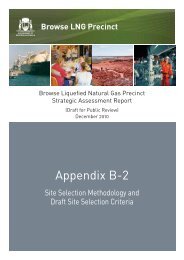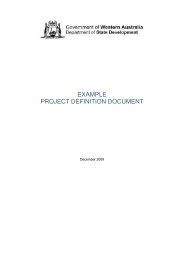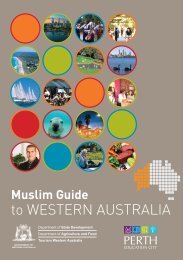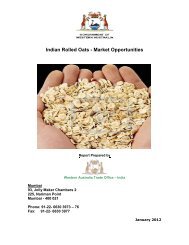Browse LNG Precinct - Public Information Booklet - Department of ...
Browse LNG Precinct - Public Information Booklet - Department of ...
Browse LNG Precinct - Public Information Booklet - Department of ...
You also want an ePaper? Increase the reach of your titles
YUMPU automatically turns print PDFs into web optimized ePapers that Google loves.
<strong>Public</strong> <strong>Information</strong> <strong>Booklet</strong><br />
the support <strong>of</strong> modelling what needs to be done to control the dredge plume (cloudiness<br />
in the water).<br />
Questions:<br />
� Do any plants and animals die during dredging?<br />
� What are the environmental effects <strong>of</strong> dredging?<br />
The key risks to plants and animals from dredging are a result <strong>of</strong> the generation <strong>of</strong><br />
sediment plumes (cloudiness in the water) in the area around dredging activities. This<br />
sediment plume/cloudiness could cause temporary disturbance to fish, mammals, reptiles<br />
etc which could result in these species temporarily moving away from the area. This<br />
however would be a temporary behaviour change and once the sediment settles these<br />
species would resume normal behaviour patterns.<br />
Dredging, which involves removal <strong>of</strong> sediment form the sea bed, can directly cause loss<br />
<strong>of</strong> sea grass and corals if they are situated on the seabed that is dredged. The<br />
environmental impact assessment identifies areas <strong>of</strong> seagrass, coral, algae etc and the<br />
port layout, channel etc are designed to minimise impacts to these habitats.<br />
There is also a risk <strong>of</strong> impact to these marine habitats from the dredge plume in the water<br />
generated. Dredge plumes/cloudiness in the water can spread out and potentially<br />
smother algae, sea grass etc as the sediment settles. The environmental impact<br />
assessment will determined the extent <strong>of</strong> the dredge plume and predict the likely area <strong>of</strong><br />
marine habitats potentially impacted. The dredging will then be designed to minimise this<br />
impact to an acceptable level.<br />
Question ñ What are the likely impacts on reefs? Is this linked to drilling for the<br />
jetty?<br />
The nearshore marine environment/saltwater country consists <strong>of</strong> sandy patches and an<br />
extensive rocky platform extending from the shore. There are no coral reefs close to the<br />
site, although there are some small patches <strong>of</strong> isolated coral and sparse sea grasses,<br />
particularly in the northern area.<br />
Construction <strong>of</strong> the jetty, breakwater and other marine facilities will likely involve piling<br />
and dredging in the nearshore marine environment. Depending on the location <strong>of</strong> the<br />
site, the impacts to the marine environment including the rocky platform will include some<br />
physical disturbance (e.g. holes drilled into the rocky bottom to stabilise the jetty) and also<br />
temporary disturbance from sediments which become stirred up during the process.<br />
The Environmental Impact Assessment (EIA) being undertaken by the State in<br />
cooperation with Woodside aims to identify the impacts to elements <strong>of</strong> the environment<br />
(including areas <strong>of</strong> reef, sea grass etc) and development measures to reduce these<br />
impacts to acceptable levels.<br />
Question - How long until the sea life comes back after dredging?<br />
Sediment plumes (cloudiness <strong>of</strong> the water) caused by dredging temporarily affect water<br />
quality in the area around the activities. The higher turbidity <strong>of</strong> these waters could cause<br />
some species to temporarily move away from the area, however these are likely to<br />
5279225 60









